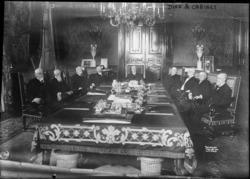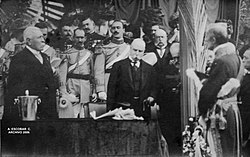Enrique Creel
Enrique C. Creel | |
|---|---|
 | |
| Minister of Foreign Affairs | |
| In office April 1910 – March 1911[1] | |
| President | Porfirio Díaz |
| Preceded by | Ignacio Mariscal[2] |
| Succeeded by | Francisco León de la Barra[2] |
| Governor of Chihuahua | |
| In office 4 October 1907 – April 1910[1] | |
| Preceded by | José María Sánchez |
| Succeeded by | José María Sánchez |
| In office 18 August 1904 – December 1906[1] | |
| Preceded by | Luis Terrazas |
| Succeeded by | José María Sánchez |
| Personal details | |
| Born | 30 August 1854[3] Chihuahua, Chihuahua[3] |
| Died | 18 August 1931 (aged 76)[3] Mexico City[3] |
| Nationality | Mexican |
| Relatives | Luis Terrazas (father-in-law) Santiago Creel (great-grandson)[4] Lola Creel (great-granddaughter) |
| Alma mater | University of Pennsylvania[5] |
José Enrique Clay Ramón de Jesús Creel Cuilty,[6] sometimes known as Henry Clay Creel (30 August 1854 – 18 August 1931) was a Mexican businessman, politician and diplomat, member of the powerful Creel-Terrazas family of Chihuahua. He was a member of the Científicos, as well as founder and president of the Banco Central Mexicano, vice-president of Kansas City, Mexico and Orient Railway, as well as governor of Chihuahua on two occasions, ambassador of Mexico to the United States, and Minister of Foreign Affairs of President Porfirio Díaz in the last years of his regime.[5][7][8] The foremost banker during the Porfirato (1876-1910) he is considered a symbol of the Porfirian regime.[9]
Biography
[edit]

Creel was born on 30 August 1850 in Ciudad Chihuahua, Chihuahua. He was the son of Paz Cuilty Bustamante, a Mexican woman, and Reuben W. Creel, an American of English descent[10] from Greensburg, Kentucky. Reuben was an interpreter for the American army during the Mexican American War, and remained in Mexico after the war ended. Reuben was also who served as Abraham Lincoln's US Consul in Chihuahua from 1863 to 1866.[11] Enrique Creel became son-in-law of Don Luis Terrazas by virtue of marriage to his daughter Angela (Reuben Creel and Luis Terrazas were married to sisters of the wealthy Cuilty family, whose ancestry was English and was related to Sir Thomas More).[citation needed]
After Porfirio Díaz became president of Mexico in 1876, he appointed Creel as a director of the National Board of Dynamite and Explosives. Mexico's demand for explosives was high because of its mining and railroad industries and the army's need for munitions. The board imposed an 80% import duty on dynamite, allowing its members to manufacture explosives without competition and reportedly enabling Creel to amass an even larger fortune in kickbacks.[citation needed]
In 1898, he founded the Banco Central Mexicano (of which he became president) alongside other members of the Científicos.[12]

Enrique Creel served as Mexico's Minister of Foreign Relations and as its Ambassador to the United States. The bilingual Creel served as interpreter when Presidents Porfirio Díaz and William Howard Taft met in 1909 on the international bridge between Ciudad Juárez and El Paso. He became vice-president of the Kansas City, Mexico and Orient Railway, where he was responsible for the construction of part of the railroad west of Chihuahua, now the Chihuahua Pacific Railroad (Ferrocarril Chihuahua al Pacífico) which runs through the town of Creel, Chihuahua. He was a key intermediary between the Mexican government and foreign companies, serving on their boards, as well as helping arrange "government subsidies and tax abatements and financial support for foreign firms."[13] His haciendas once totaled more than 1.7 million acres (6,900 km2).[citation needed] Creel was one of Díaz's advisers who had urged the president to be interviewed by James Creelman of Pearson's Magazine, in which Díaz declared he would not be a candidate for president in 1910.[14]
The Mexican Revolution forced him to abandon Mexico for the United States and he had major financial losses due to the Revolution, with revolutionaries expropriating his landed estates.[15] He returned after the end of the revolution, and served for a period in the administration of northern revolutionary general Alvaro Obregón (1920–24).[14] He died in Mexico City on August 18, 1931 .[3]
Publications
[edit]- Los bancos de México (English: The Banks of Mexico)[5]
- Importación y exportación (Imports and Exports)[5]
- Agricultura y agrarismo (Agriculture and Agrarianism)[5]
See also
[edit]- Creel-Terrazas Family, a powerful and wealthy family from Chihuahua founded by Luis Terrazas, his father-in-law.
References
[edit]- ^ a b c El comercio en la historia de Chihuahua: reseña histórica, biografías. informes de ejercicios 1989-1990 (in Spanish). Chihuahua, Mexico: Camara Nacional de Comercio, Servicios y Turismo de Chihuahua. 1991. Archived from the original on 2011-07-22. Retrieved 2009-12-08.
- ^ a b "Enrique C. Creel Cuilty" (in Spanish). Mexico: Secretaría de Relaciones Exteriores. Retrieved 8 December 2009.
- ^ a b c d e Romero Sotelo, María Eugenia (2006). "Bimetalismo vs. Patrón oro, una larga controversia en México: la Comisión de Cambios Internacional y la Comisión Monetaria de 1903". In Romero Sotelo; María Eugenia; Ludlow, Leonor (eds.). Temas a debate: moneda y banca en México 1884-1954. Serie Historia moderna y contemporánea (in Spanish). Vol. 45. Mexico City: Universidad Nacional Autónoma de México. p. 64. ISBN 9789703235728. OCLC 76858975. Retrieved 2009-12-07.
- ^ Contreras, Jorge (2023-07-27). "¿Cómo se relaciona un pueblo de Chihuahua con Santiago Creel y por qué lleva su apellido?" (in Spanish). Infobae. Retrieved 2024-03-02.
- ^ a b c d e Tablada, José Juan (2006). Obras: en el país del sol. Nueva biblioteca mexicana (in Spanish). Vol. 25. Mexico City: Universidad Nacional Autónoma de México. p. 28. ISBN 9789703225842. OCLC 166280723. Retrieved 2009-12-08.
- ^ Almada 1980, p. 437
- ^ Mark Wasserman, Capitalists, Caciques, and Revolution: the Native Elite and Foreign Enterprise in Chihuahua, Mexico. Chapel Hill: University of North Carolina Press 1984.
- ^ Mark Wasserman, "Enrique C. Creel: Business and Politics in Mexico, 1880-1930." Business History Review 59 (Winter 1985).
- ^ Mark Wasserman, "Enrique Clay Creel" in Encyclopedia of Mexico vol. 1, p. 370. Chicago: Fitzroy and Dearborn 1997.
- ^ Chico y Pardo 2009, p. 627.
- ^ "Unique Father And Son". Kentucky Historical Society. Retrieved 2024-10-27.
- ^ "Banco Central Mexicano. UNAM-Universidad Nacional Autónoma de México" (PDF).
- ^ Wasserman, "Enrique Clay Creel" p. 369.
- ^ a b Wasserman, "Enrique Clay Creel", p. 370.
- ^ Wasserman, "Enrique Clay Creel", p. 370
Bibliography
[edit]- Almada, Francisco R. (1980). Gobernadores del Estado de Chihuahua (in Spanish). Centro Librero La Prensa.
- Chico y Pardo, Maria Elena (2009). "Enrique C. Creel Cuilty". Cancilleres de México (PDF) (in Spanish). México: Secretaría de Relaciones Exteriores. pp. 626–641. ISBN 978-968-810-389-0. Archived from the original (PDF) on 2012-06-26.
Further reading
[edit]- Caballero, Raymond (2017). Orozco: Life and Death of a Mexican Revolutionary. Norman OK: University of Oklahoma Press.
- Caballero, Raymond (2020). Pascual Orozco, ¿Héroe y traidor?. México, D.F.: Siglo XXI Editores.
- People from Chihuahua City
- 1854 births
- 1931 deaths
- Secretaries of foreign affairs of Mexico
- Governors of Chihuahua (state)
- Members of the Chamber of Deputies (Mexico)
- Ambassadors of Mexico to the United States
- Mexican people of German descent
- Mexican people of English descent
- Mexican people of American descent
- Politicians from Chihuahua (state)
- Liberalism in Mexico
- Mexican people of Irish descent
- 20th-century Mexican politicians
- People from Chihuahua (state)
